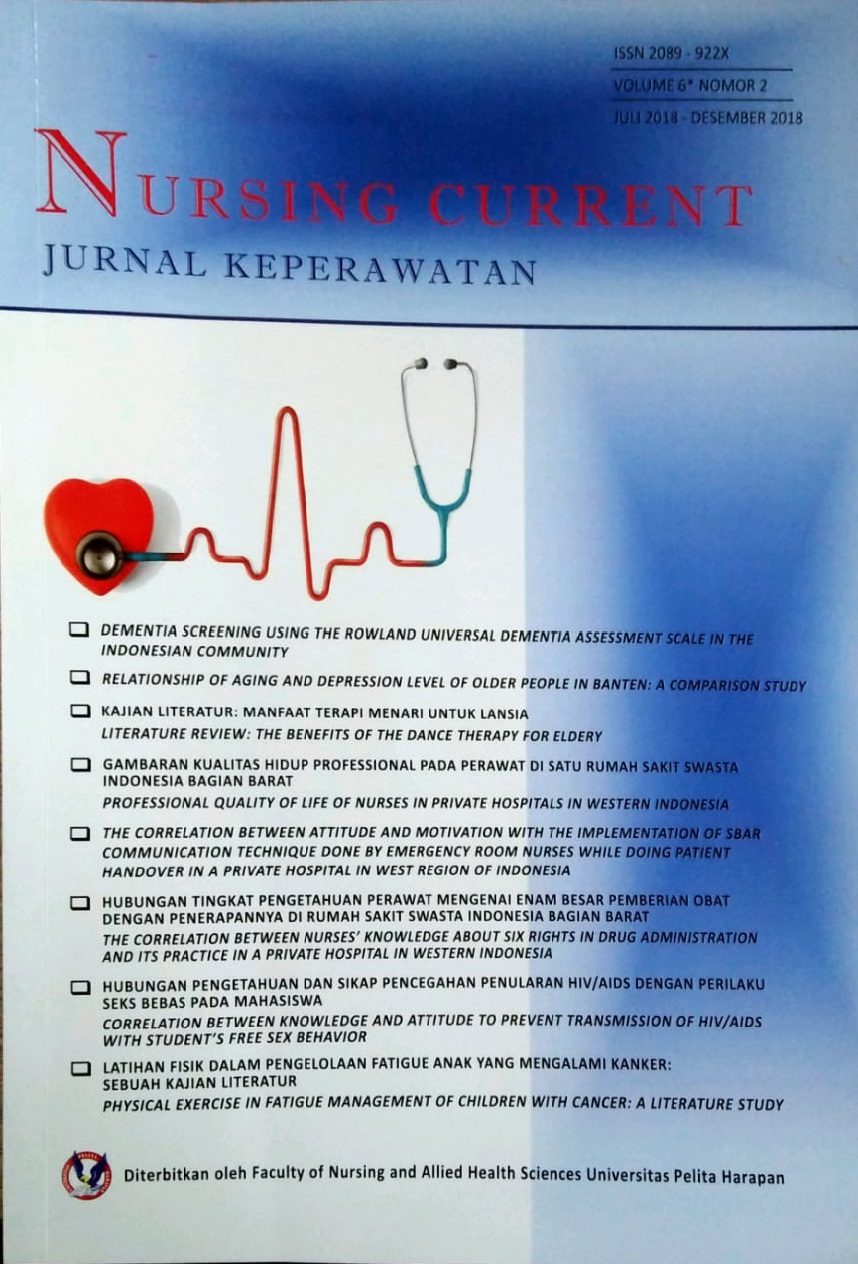LITERATURE REVIEW: THE BENEFITS OF DANCE THERAPY FOR ELDERY [KAJIAN LITERATUR: MANFAAT TERAPI MENARI UNTUK LANSIA]
DOI:
https://doi.org/10.19166/nc.v6i2.1860Λέξεις-κλειδιά:
Dance Therapy, Quality of Life, ElderlyΠερίληψη
A setback that occurs in elderly impacted on the decline in the physical aspect, psychological, social and environmental. This calls for a unexplainable intervention that can reach all of that experienced the decline. Dancing is one of physical activity therapy that often used in the world for the elder, both facing health problems or a healthy elderly. A literature review uses PRISMA statement as a guide search of articles of the three databases such as Science Direct, Scopus and ProQuest. The results of the analysis ten elected articles are dance therapy very effective and has benefit to the physical aspect, psychological, social and environmental. The benefits have positive implications for the potential ability of the elderly to live their lives so that the quality of life of the elderly increases. The application of dance therapy has potential to be done in the order of primary health services in Indonesia which is supported by many variance of Indonesian dances so that the related research and publications are needed to influence the health care policy of the elderly.
BAHASA INDONESIA ABSTRAK Kemunduran yang terjadi pada lansia berdampak pada penurunan aspek fisik, psikologis, sosial dan lingkungan. Hal ini membutuhkan suatu intervensi yang dapat menjangkau seluruh aspek yang mengalami penurunan tersebut. Terapi menari adalah salah satu terapi aktifitas fisik yang banyak dimanfaatkan di dunia untuk lansia, baik yang mengalami masalah kesehatan ataupun lansia yang sehat. Kajian pustaka ini menggunakan PRISMA statement sebagai panduan pencarian artikel penelitian dari tiga database yaitu Science Direct, Scopus dan ProQuest. Hasil analisis sepuluh artikel penelitian terpilih menunjukkan bahwa terapi menari efektif dan memiliki manfaat untuk aspek fisik, psikologis, sosial dan lingkungan lansia. Manfaat yang dihasilkan berimplikasi positif pada kemampuan potensial lansia dalam menjalani hidupnya sehingga kualitas hidup lansia meningkat. Penerapan terapi menari ini potensial dilakukan di tatanan pelayanan kesehatan primer di Indonesia yang didukung banyaknya pilihan tarian Indonesia sehingga penelitian dan publikasi terkait diperlukan untuk memengaruhi kebijakan pelayanan kesehatan lansia.
Αναφορές
Badan Pusat Statistik. (n.d.). Statistik penduduk lanjut usia 2017. https://www.bps.go.id/publication/2020/12/21/0fc023221965624a644c1111/statistik-penduduk-lanjut-usia-2020.html
Conceição, L. S., Neto, M. G., Amaral, M. A., Martins-Filho, P. R., & Carvalho, V. O. (2016). Effect of dance therapy on blood pressure and exercise capacity of individuals with hypertension: A systematic review and meta-analysis. International Journal of Cardiology, 220, 553-557. https://doi.org/10.1016/j.ijcard.2016.06.182
Cruz-Ferreira, A., Marmeleira, J., Formigo, A., Gomes, D., & Fernandes, J. (2015). Creative dance improves physical fitness and life satisfaction in older women. Research on Aging, 37(8), 837-855. https://doi.org/10.1177/0164027514568103
Delextrat, A., Bateman, J., Esser, P., Targen, N., & Dawes, H. (2016). The potential benefits of Zumba Gold® in people with mild-to-moderate Parkinson’s: Feasibility and effects of dance styles and number of sessions. Complementary Therapies in Medicine, 27, 68-73. https://doi.org/10.1016/j.ctim.2016.05.009
Franco, M. R., Sherrington, C., Tiedemann, A., Pereira, L. S., Perracini, M. R., Faria, C. R., . . . Pastre, C. M. (2016). Effectiveness of senior dance on risk factors for falls in older adults (DanSE): A study protocol for a randomised controlled trial. BMJ Open, 6(12). https://doi.org/10.1136/bmjopen-2016-013995
Gouvêa, J. A., Antunes, M. D., Bortolozzi, F., Marques, A. G., & Bertolini, S. M. (2017). Impact of senior dance on emotional and motor parameters and quality of life of the elderly. Revista Da Rede De Enfermagem Do Nordeste, 18(1), 51. https://doi.org/10.15253/2175-6783.2017000100008
Guillaume, A. (2017). Dance therapy: A new approach to minimising the impact of ailments caused by old age. (2017). Perspectives in Public Health, 137(2), 80-80. https://doi.org/10.1177/1757913916685541
Guzmán, A., Freeston, M., Rochester, L., Hughes, J. C., & James, I. A. (2016). Psychomotor Dance Therapy Intervention (DANCIN) for people with dementia in care homes: A multiple-baseline single-case study. International Psychogeriatrics, 28(10), 1695-1715. https://doi.org/10.1017/S104161021600051X
Hackney, M. E., Byers, C., Butler, G., Sweeney, M., Rossbach, L., & Bozzorg, A. (2015). Adapted Tango improves mobility, motor-cognitive function, and gait but not cognition in older adults in independent living. Journal of the American Geriatrics Society, 63(10), 2105-2113. https://doi.org/10.1111/jgs.13650
Hwang, P. W.-N., & Raun, K. L. (2015). The effectiveness of dance interventions to improve older adults’ health: A systematic literature review. Alternative Therapies in Health and Medicine, 21(5), 64-70, 21(5), 64-70. https://www.ncbi.nlm.nih.gov/pmc/articles/PMC5491389/
Keogh, J. W., Kilding, A., Pidgeon, P., Ashley, L., & Gillis, D. (2009). Physical benefits of dancing for healthy older adults: A review. Journal of Aging and Physical Activity, 17(4), 479-500. https://doi.org/10.1123/japa.17.4.479
Lazarou, I., Parastatidis, T., Tsolaki, A., Gkioka, M., Karakostas, A., Douka, S., & Tsolaki, M. (2017). International ballroom dancing against neurodegeneration: A randomized controlled trial in Greek community-dwelling elders with mild cognitive impairment. American Journal of Alzheimer's Disease & Other Dementias, 32(8), 489-499. https://doi.org/10.1177/1533317517725813
Lewis, C., Annett, L. E., Davenport, S., Hall, A. A., & Lovatt, P. (2014). Mood changes following social dance sessions in people with Parkinson’s disease. Journal of Health Psychology, 21(4), 483-492. https://doi.org/10.1177/1359105314529681
Liberati, A. (2009). The PRISMA Statement for reporting systematic reviews and meta-analyses of studies that evaluate health care interventions: Explanation and elaboration. Annals of Internal Medicine, 151(4). https://doi.org/10.1016/j.jclinepi.2009.06.006
Machacova, K., Vankova, H., Volicer, L., Veleta, P., & Holmerova, I. (2015). Dance as prevention of late life functional decline among nursing home residents. Journal of Applied Gerontology, 36(12), 1453-1470. https://doi.org/10.1177/0733464815602111
Miller, C. A. (2012). Nursing wellness in older adults. Lippincot Williams & Wilkins.
Minde, G. (2015). A Culturally-sensitive approach to elderly care. Journal of Gerontology & Geriatric Research, 04(05). https://doi.org/10.4172/2167-7182.1000249
Moher, D., Liberati, A., Tetzlaff, J., & Altman, D. G. (2009). Preferred reporting items for systematic reviews and meta-analyses: The PRISMA Statement. PLoS Medicine, 6(7). https://doi.org/10.1371/journal.pmed.1000097
Rocha, P. A., Slade, S. C., Mcclelland, J., & Morris, M. E. (2017). Dance is more than therapy: Qualitative analysis on therapeutic dancing classes for Parkinson’s. Complementary Therapies in Medicine, 34, 1-9. https://doi.org/10.1016/j.ctim.2017.07.006
Rohmah, A. I. N. P., & Bariyah, K. (2012). Quality of life elderly. Jurnal Keperawatan, 3(2), 120-132. http://ejournal.umm.ac.id/index.php/keperawatan/article/view/2589/3234
Roswiyani, R., Kwakkenbos, L., Spijker, J., & Witteman, C. L. M. (2017). The effectiveness of combining visual art activities and physical exercise for older adults on well-being or quality of life and mood: A scoping review. Journal of Applied Gerontology, 1-22. https://doi.org/10.1177/0733464817743332
Ruastiti, N. M., Suharta, I. W., & Suryani, N. N. M. (2015). Revitalisasi tari janger lansia di kelurahan Tonja Denpasar. Segara Widya, 3(1), 368-372. https://doi.org/10.31091/sw.v3i0.173
Serrano-Guzmán, M., Valenza-Peña, C. M., Serrano-Guzmán, C., Aguilar-Ferrándiz, E., Valenza-Demet, G., & Villaverde-Gutiérrez, C. (2016). Effects of a dance therapy programme on quality of life, sleep and blood pressure in middle-aged women: A randomised controlled trial. Medicina ClÃnica, 147(8), 334-339. https://doi.org/10.1016/j.medcli.2016.06.030
Shanahan, J., Coman, L., Ryan, F., Saunders, J., O’Sullivan, K., Ni Bhriain, O., & Clifford, A. M. (2016). To dance or not to dance? A comparison of balance, physical fitness and quality of life in older Irish set dancers and age-matched controls. Public Health, 141(2016), 56-62. https://doi.org/10.1016/j.puhe.2016.07.015
Strassel, J. K., Cherkin, D. C., Steuten, L., Sherman, K. J., & Vrijhoef, H. J. M. (2012). A systematic review of the evidence for the effectiveness of dance therapy. Alternative Therapies, 17(3), 50-59. https://pubmed.ncbi.nlm.nih.gov/22164813/
Supraba, N. P., Widarini, N. P., & Ani, L. S. (2016). Hubungan antara fungsi sosial dengan kualitas hidup lanjut usia di kota Denpasar. Public Health and Preventive Medicine Archive, 4(2), 158-162. https://doi.org/10.15562/phpma.v4i2.69
Van Esch, L., Den Oudsten, B. L., & De Vries, J. (2011). The world health organization quality of life instrument-short form (WHOQOL-BREF) in women with breast problems. International Journal of Clinical and Health Psychology,11(1), 5-22. https://research.tilburguniversity.edu/en/publications/the-world-health-organization-quality-of-life-instrument-short-fo
World Health Organization. (n.d.). Ageing and health. World Health Organization. https://www.who.int/news-room/fact-sheets/detail/ageing-and-health
Λήψεις
Δημοσιευμένα
Πώς να δημιουργήσετε Αναφορές
Τεύχος
Ενότητα
Άδεια
Authors who publish with this journal agree to the following terms:
1) Authors retain copyright and grant the journal right of first publication with the work simultaneously licensed under a Creative Commons Attribution License (CC-BY-SA 4.0) that allows others to share the work with an acknowledgement of the work's authorship and initial publication in this journal.
2) Authors are able to enter into separate, additional contractual arrangements for the non-exclusive distribution of the journal's published version of the work (e.g., post it to an institutional repository or publish it in a book), with an acknowledgement of its initial publication in this journal.
3) Authors are permitted and encouraged to post their work online (e.g., in institutional repositories or on their website). The final published PDF should be used and bibliographic details that credit the publication in this journal should be included.

This work is licensed under a Creative Commons Attribution-ShareAlike 4.0 International License.






